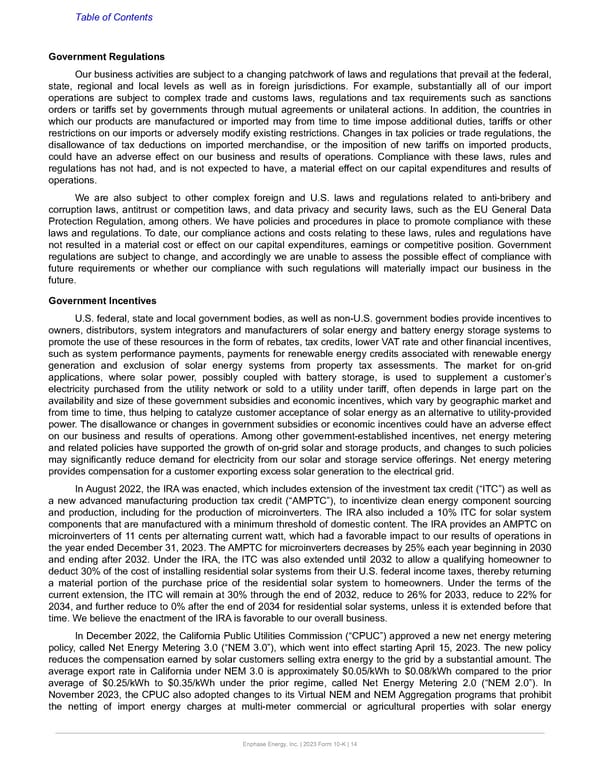Table of Contents Government Regulations Our business activities are subject to a changing patchwork of laws and regulations that prevail at the federal, state, regional and local levels as well as in foreign jurisdictions. For example, substantially all of our import operations are subject to complex trade and customs laws, regulations and tax requirements such as sanctions orders or tariffs set by governments through mutual agreements or unilateral actions. In addition, the countries in which our products are manufactured or imported may from time to time impose additional duties, tariffs or other restrictions on our imports or adversely modify existing restrictions. Changes in tax policies or trade regulations, the disallowance of tax deductions on imported merchandise, or the imposition of new tariffs on imported products, could have an adverse effect on our business and results of operations. Compliance with these laws, rules and regulations has not had, and is not expected to have, a material effect on our capital expenditures and results of operations. We are also subject to other complex foreign and U.S. laws and regulations related to anti-bribery and corruption laws, antitrust or competition laws, and data privacy and security laws, such as the EU General Data Protection Regulation, among others. We have policies and procedures in place to promote compliance with these laws and regulations. To date, our compliance actions and costs relating to these laws, rules and regulations have not resulted in a material cost or effect on our capital expenditures, earnings or competitive position. Government regulations are subject to change, and accordingly we are unable to assess the possible effect of compliance with future requirements or whether our compliance with such regulations will materially impact our business in the future. Government Incentives U.S. federal, state and local government bodies, as well as non-U.S. government bodies provide incentives to owners, distributors, system integrators and manufacturers of solar energy and battery energy storage systems to promote the use of these resources in the form of rebates, tax credits, lower VAT rate and other financial incentives, such as system performance payments, payments for renewable energy credits associated with renewable energy generation and exclusion of solar energy systems from property tax assessments. The market for on-grid applications, where solar power, possibly coupled with battery storage, is used to supplement a customer’s electricity purchased from the utility network or sold to a utility under tariff, often depends in large part on the availability and size of these government subsidies and economic incentives, which vary by geographic market and from time to time, thus helping to catalyze customer acceptance of solar energy as an alternative to utility-provided power. The disallowance or changes in government subsidies or economic incentives could have an adverse effect on our business and results of operations. Among other government-established incentives, net energy metering and related policies have supported the growth of on-grid solar and storage products, and changes to such policies may significantly reduce demand for electricity from our solar and storage service offerings. Net energy metering provides compensation for a customer exporting excess solar generation to the electrical grid. In August 2022, the IRA was enacted, which includes extension of the investment tax credit (“ITC”) as well as a new advanced manufacturing production tax credit (“AMPTC”), to incentivize clean energy component sourcing and production, including for the production of microinverters. The IRA also included a 10% ITC for solar system components that are manufactured with a minimum threshold of domestic content. The IRA provides an AMPTC on microinverters of 11 cents per alternating current watt, which had a favorable impact to our results of operations in the year ended December 31, 2023. The AMPTC for microinverters decreases by 25% each year beginning in 2030 and ending after 2032. Under the IRA, the ITC was also extended until 2032 to allow a qualifying homeowner to deduct 30% of the cost of installing residential solar systems from their U.S. federal income taxes, thereby returning a material portion of the purchase price of the residential solar system to homeowners. Under the terms of the current extension, the ITC will remain at 30% through the end of 2032, reduce to 26% for 2033, reduce to 22% for 2034, and further reduce to 0% after the end of 2034 for residential solar systems, unless it is extended before that time. We believe the enactment of the IRA is favorable to our overall business. In December 2022, the California Public Utilities Commission (“CPUC”) approved a new net energy metering policy, called Net Energy Metering 3.0 (“NEM 3.0”), which went into effect starting April 15, 2023. The new policy reduces the compensation earned by solar customers selling extra energy to the grid by a substantial amount. The average export rate in California under NEM 3.0 is approximately $0.05/kWh to $0.08/kWh compared to the prior average of $0.25/kWh to $0.35/kWh under the prior regime, called Net Energy Metering 2.0 (“NEM 2.0”). In November 2023, the CPUC also adopted changes to its Virtual NEM and NEM Aggregation programs that prohibit the netting of import energy charges at multi-meter commercial or agricultural properties with solar energy Enphase Energy, Inc. | 2023 Form 10-K | 14
 Annual Report Page 13 Page 15
Annual Report Page 13 Page 15